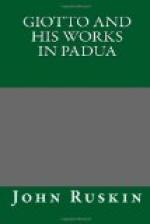[Footnote 7: Notes to Rogers’ Italy.]
Indeed, I can hardly imagine the Bible to be ever read with true interest, unless, in our reading, we feel some longing for further knowledge of the minute incidents of the life of Christ,—for some records of those things, which “if they had been written every one,” the world could not have contained the books that should be written: and they who have once felt this thirst for further truth, may surely both conceive and pardon the earnest questioning of simple disciples (who knew not, as we do, how much had been indeed revealed), and measure with some justice the strength of the temptation which betrayed these teachers into adding to the word of Revelation. Together with this specious and subtle influence, we must allow for the instinct of imagination exerting itself in the acknowledged embellishment of beloved truths. If we reflect how much, even in this age of accurate knowledge, the visions of Milton have become confused in the minds of many persons with scriptural facts, we shall rather be surprised, that in an age of legends so little should be added to the Bible, than that occasionally we should be informed of important circumstances in sacred history with the collateral warning, “This Moses spake not of."[8]
[Footnote 8: These words are gravely added to some singular particulars respecting the life of Adam, related in a MS. of the sixteenth century preserved in the Herald’s College.]
More especially in the domain of painting, it is surprising to see how strictly the early workmen confined themselves to representations of the same series of scenes; how little of pictorial embellishment they usually added; and how, even in the positions and gestures of figures, they strove to give the idea rather of their having seen the fact, than imagined a picturesque treatment of it. Often, in examining early art, we mistake conscientiousness for servility, and attribute to the absence of invention what was indeed the result of the earnestness of faith.
Nor, in a merely artistical point of view, is it less important to note, that the greatest advance in power was made when painters had few subjects to treat. The day has perhaps come when genius should be shown in the discovery of perpetually various interest amidst the incidents of actual life; and the absence of inventive capacity is very assuredly proved by the narrow selection of subjects which commonly appear on the walls of our exhibitions. But yet it is to be always remembered, that more originality may be shown in giving interest to a well-known subject than in discovering a new one; that the greatest poets whom the world has seen have been contented to retouch and exalt the creations of their predecessors; and that the painters of the middle ages reached their utmost power by unweariedly treading a narrow circle of sacred subjects.




